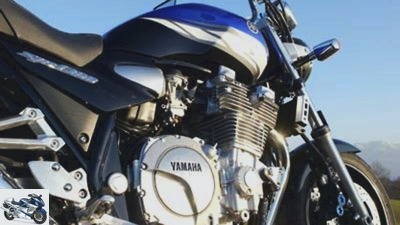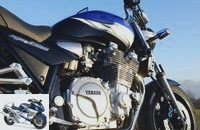Menus

Jahn
Top test Yamaha XJR 1300
The original
Yamaha took a lot of time with their debut, but the successful XJR series proves staying power. She has long been part of the establishment. The revised 2004 model in the top test.
The story of the XJR began
with a historical error. Back in 1994, almost everyone thought Yamaha was missing out on an opportunity. The big bike revival was already in full swing: the Honda CB 1000, Kawasaki Zephyr 1100 and Co. caused a sensation. But Yamaha didn’t seem to care. In Europe, there was not much interest in such a motorcycle, it was rumored from company circles. In Japan, on the other hand, there was an XJR 1200. The editors did not want to wait until Santa Claus for this big bike and organized a Japanese version. After the test, his colleague Jupp Schmitz oracle: “Behind the late presentation of the XJR there are well-calculated delaying tactics, based on the motto: wait and see, drink tea and see what the competition can do and then go one better.”
How right he should be. Because the XJR came slowly from September 1995, but all the more powerful. And has many there-
maligen and some later bankruptcies-
Rentinnen survived. Latest victim: the
Honda X-11, which is no longer part of the German program for 2004. The mighty Yamaha apparently has the more coherent, because more timeless, concept. Similar to the legendary Levis 501, which never goes out of style.
During the intensive study of various tests in recent years, another curiosity emerges. The XJR has never been a potential winner in comparison tests. She politely left the place in the sun to others. As if she knew about her unique personality-
opportunity. A classless motorcycle that connects. In the past few years, hosts of frustrated cruiser drivers ?? looking for more dynamic ?? and stressed out super sports fans who longed for more, much more comfort, have defected to the XJR. She brings performance and style to a common denominator
you can be seen everywhere. That works.
Especially since Yamaha introduced the XJR 1300 in 1999. Larger displacement ?? the final breakthrough. The most important changes: forged pistons, coated aluminum cylinders, mapped ignition with a throttle valve sensor, a larger oil cooler, which are almost gone today-
dare brake system of the R1, a facelift for side and rear panels and ?? last but not least ?? Contemporary tire dimensions: at the front finally a 120 instead of the rare 130 format, a wider 180 at the rear.
However, the more powerful, modernized version did not achieve glorious test wins either. MOTORRAD criticized the inharmonious suspension setup like a mantra. At the rear, stereo struts of various origins were used, but their tuning was sometimes too hard and insensitive, in the case of the exclusive one-
ren XJR in SP performance surprised the Ohlins struts as softies. The fork, in turn, shone with a very sensitive response, but was hopelessly underdamped and had springs that were far too soft. New-
Modifications for the 2002 model year resulted in barely noticeable verbs-
If you ignore the previously laudable seating position that is now even more comfortable for driver and passenger.
The unbalanced vote leads to-
te to deduct points, also with the braking and cornering stability and the lean angle. In short: this dignified, wonderfully crafted motorcycle with its powerful and smooth-running four-cylinder engine was easy to miss. Yamaha was provocative again
much time. So you can safely assume,
that the Euro 2 emissions standard is not entirely innocent of the modifications for the 2004 model. This made unregulated catalytic converters necessary. Surprisingly, the Japanese left it with carburetors instead of converting to intake manifold injection in one go.
And while we’re at it, we’re going to give the good piece another suspension set-up? it has to be one way or another
ran at Yamaha this time. Dear tuner, do not expect the XJR to grow significantly in the future when it comes to chassis accessories. Someone in Japan actually found usable springs for the bolide. To speak of a perfect harmony of the front and rear end would be an exaggeration, the fork should still be a bit harder. But the direction is correct. Although the Yamaha loses some of its litter-like comfort at the front, the gain in driving pleasure is immense.
What can be experienced in the top test course, which cannot be spared even such a classic. Tester Karsten Schwers managed with a light hand befitting times in the fast and slow slalom comparable to the direct competition. A tighter suspension setup means more peace and quiet for the thick ship. At the same time, it improves accuracy and handiness. The latter point is
the XJR is now even superior to the Honda CB 1300. The new, lighter rims may also contribute to this in part. It has remained a bit as before
wobbly turning behavior.
In the hunt for tenths, you also need to be free of lean angles. What the current model offers significantly more, because even with this tough test? Karsten likes to do things weird? only put the footrests on, but no more rigid parts. The MOTORRAD top tester, who was otherwise just as emotionally and mercilessly in his judgment as his test subjects, also succumbed to the charm of the fat ones. “It’s damn good to drive an XJR again.” He explains the times in the slow slalom almost apologetically: “There could have been more, but unfortunately I always clear the pylons with the thick silencers.”
So he goes a further arc and can so the inimitable pressure from abysmal speeds, of which the Yamaha despite the U-Kats nothing-
loren has to enjoy with no regrets. The four-cylinder accelerates so gently that annoying load change reactions are not perceptible, ergo neither
Can ruin the line. One more thing on the subject of performance: Yamaha officially delivers with insurance-favorable 72 kW (98 PS); a quickly done, registration-
capable conversion to 78 kW is
in principle possible, but this is demonstrably only effective in the upper speed-
area positive.
Whereby you then move on public roads in regions that are likely to score points. Flensburg, not top test points. And that is not the nature of the Yamaha. She has probably gained in sportsmanship. But that doesn’t change the fact that their potential on country roads is only roughly exhausted in exceptional cases. Not heating, but souvenir-
Smart, sporty, relaxed driving is the strength of the XJR. Which is why you should prefer to be in corridor number five of
well stepped gear moves. It’s also nice that the 1300s measurably changed their drinking habits. It consumed a good half a liter less than in the last comparison test (MOTORRAD 9/2003). Will that have a positive effect on the order in the next test? We’ll know more soon.
At the end of the day, it won’t be the brakes. Here, Yamaha has also improved the brake master cylinder and the
D.movability improved. Karsten implemented it. 10.1 m / s2 mean braking deceleration is a top value. Also ?? or just now? for an original.
Buy complete article

Top test Yamaha XJR 1300
The original
What else stood out – Yamaha XJR 1300
What else stood out PositiveDespite the revision, no price increaseExcellent considerationLowered fuel consumption NegativeOnly average lightLight shimmy (handlebar flutter) First tires Dunlop D 252 »J«; all in all harmonize well with the heavy Yamaha. Slightly wobbly turning behavior, good grip. This is also reflected in the very good deceleration values, hardly any righting moment when braking in an inclined position, but shimmy in cold and warm conditions Changes to the 2003 modelNew silencers with U-KatChanged carburetor settingsLighter three-spoke wheelsChanged double disc brakes in front Speedometer immobilizer as standard Chassis setting in the test Rear spring base: lowest level (one of three) front: four rings visible The Yamaha XJR community on the Internet: www.yamaha-xjr1200.de
Conclusion – Yamaha XJR 1300
That’s how we like it: constant model updates, no half-hearted lip service. Yamaha elicits talent from its gentle giant just as skilfully as it does unexpectedly. The tighter chassis set-up along with the modified braking system plus modified carburetor set-up are all-round successful, because the XJR 1300 wins across the board.
Related articles
-
Comparison test: Honda CX 500-650 Turbo, Kawasaki Z 750 Turbo, Suzuki XN 85, Yamaha XJ 650 Turbo
Jahn 21 pictures Jahn 1/21 The preload of the central spring strut of the Suzuki can be easily adjusted. Jahn 2/21 Tight corners and fast …
-
fact Concept comparison Honda CBR 1100 XX Kawasaki ZX-12 R Suzuki GSX-R 1000 Suzuki GSX 1400 Yamaha FZS 1000 Fazer Yamaha FJR 1300 Six bombs The six …
-
Yamaha YZF-R1 in the 50,000 km endurance test
Jacek Bilski 50 pictures Rossen Gargolov 1/50 The Yamaha YZF-R1 has passed the MOTORRAD endurance test. It took her almost 3 years for the 50,000 km …
-
32 pictures 1/32 2/32 3/32 Only limit the incline buttons on the footrests – but they use themselves …
-
Comparison test Suzuki SV 650, Honda CB 650 F, Kawasaki ER-6n, Yamaha MT-07
www.bilski-fotografie.de 34 pictures www.bilski-fotografie.de 1/34 They are the hottest candidates among the middle class naked bikes ….
-
Kawasaki Z 800, Yamaha MT-09 and BMW F 800 R in a comparison test
35 pictures 1/35 The center is no longer where it used to be. Because bikes with displacements around 800 cm³ count …
-
duke Top test Honda CB 1300 Concentrated load 116 hp, 117 Newton meters. Power and torque complement each other practically one to one in the Honda CB…
-
Yamaha FJR 1300 Tourer in the test
fact 38 pictures fact 1/38 Yamaha FJR 1300 in the top test. fact 2/38 Yamaha FJR 1300 in the top test. fact 3/38 Yamaha FJR 1300 in the top test. fact 4/38 Yamaha FJR …
-
Test of the Honda XR 600 R against the Yamaha TT 600 R
Yamaha TT 600 R. Comparison test, Honda XR 600 R, Yamaha TT 600 R Honda XR 600 R versus Yamaha TT 600 R Does it really have to be state-of-the-art,…
-
Comparison test of supersports: Honda CBR 600 F, Kawasaki ZX-6R, Suzuki GSX-R 600, Yamaha YZF 600 R
Comparison test of super sports cars: Honda CBR 600 F, Kawasaki ZX-6R, Suzuki GSX-R 600, Yamaha YZF 600 R Let’s twist again Wake up, people. In the 600s …